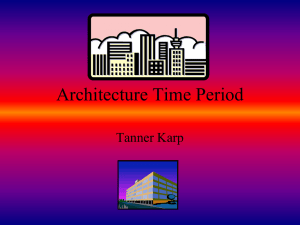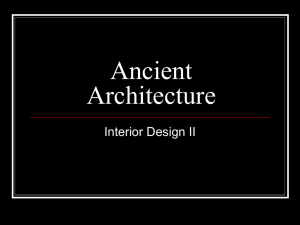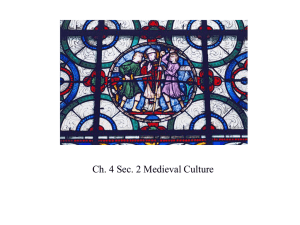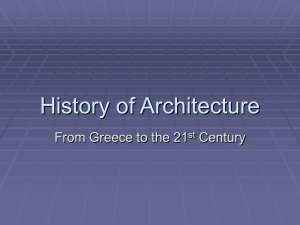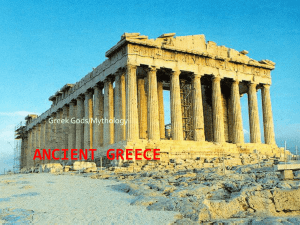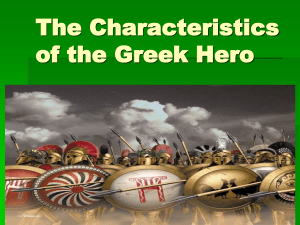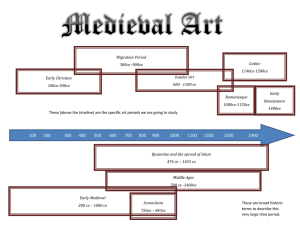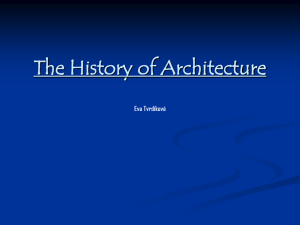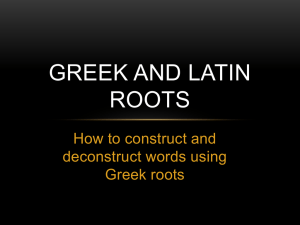Notes for the Units Classical to Medieval Greek Art 900
advertisement
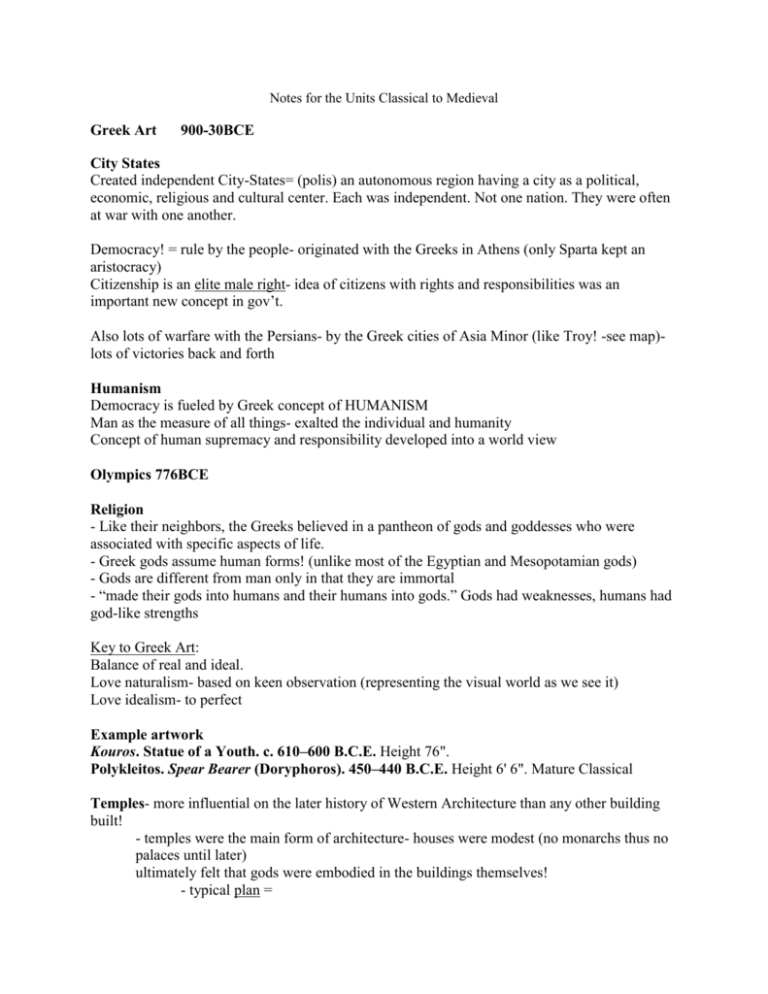
Notes for the Units Classical to Medieval Greek Art 900-30BCE City States Created independent City-States= (polis) an autonomous region having a city as a political, economic, religious and cultural center. Each was independent. Not one nation. They were often at war with one another. Democracy! = rule by the people- originated with the Greeks in Athens (only Sparta kept an aristocracy) Citizenship is an elite male right- idea of citizens with rights and responsibilities was an important new concept in gov’t. Also lots of warfare with the Persians- by the Greek cities of Asia Minor (like Troy! -see map)lots of victories back and forth Humanism Democracy is fueled by Greek concept of HUMANISM Man as the measure of all things- exalted the individual and humanity Concept of human supremacy and responsibility developed into a world view Olympics 776BCE Religion - Like their neighbors, the Greeks believed in a pantheon of gods and goddesses who were associated with specific aspects of life. - Greek gods assume human forms! (unlike most of the Egyptian and Mesopotamian gods) - Gods are different from man only in that they are immortal - “made their gods into humans and their humans into gods.” Gods had weaknesses, humans had god-like strengths Key to Greek Art: Balance of real and ideal. Love naturalism- based on keen observation (representing the visual world as we see it) Love idealism- to perfect Example artwork Kouros. Statue of a Youth. c. 610–600 B.C.E. Height 76". Polykleitos. Spear Bearer (Doryphoros). 450–440 B.C.E. Height 6' 6". Mature Classical Temples- more influential on the later history of Western Architecture than any other building built! - temples were the main form of architecture- houses were modest (no monarchs thus no palaces until later) ultimately felt that gods were embodied in the buildings themselves! - typical plan = - central room surrounded by single or double row of columns= Peripteral temple= colonnade runs around all 4 sides - rectangular overall shape, pitched roof - altar lay outside on East end (rising sun), people worshipped outside - temple held cult statue- house of god or goddess not his/her worshippers - always appeal to Greek sense of symmetry, order, compactness and mathematical relationships- cosmic order! - made of limestone and often marble Architectural Orders ORDERS: temple elevations- arrangement, proportions, and appearance of columns and entablatures Gmaps/line art16 1. Doric- mainland Greece- earliest simplest, most commonly used (capital is simple, cushion) 2. Ionic- from Asia Minor and the Aegeans- more ornate, generally for smaller temples (capital is scroll, volute) 3. Corinthian- most intricate- used later and mainly inside- favorite of Romans and used most by Romans. (capital is overlapping ancanthus leaves) cornice- projecting horizontal band Pediment= triangular member found by the slope of the roof at the short ends of temple. Entablature= horizontal member that bears the weight of the roof including: 1. frieze- contains sculptural decoration (triglyph and metope for Doric) triglyph probably corresponds to the ends of timber now translated into stone. 2. architrave- solid band for Doric, 3 bands for Ionic capital column Example artwork Ictinus and Callicrates. Parthenon, view from southwest. Athens, Greece 448–432 B.C.E. Recap: Greek artists create a new way of depicting humans figures in space (contrapposto in sculpture) Canon of proportions- the belief that harmonious proportions create beauty Harmonious numerical ratios also used in architecture Roman Art 509BCE-500CE ReligionAdopted many Greek gods and myths, added their own gods and added deified emperors. Example artwork Portrait of Augustus as general, from Primaporta, Italy, copy of a bronze original of ca. 20 BCE. Marble, 6’ 8” high. Vatican Museums, Rome. Roman houses Domestic architecture occupies a prominent place in Roman civilization. Home family and hearth was sacred. Emphasized interior not exterior. Mt. Vesuvius Volanic eruption in 79AD during early empire. Forum- public square for daily commerce and for holding festivals- had a chief side, unlike the Greek building which stood in isolation and could be approached from any side- during the empire each emperor usually made their own forums including statues that pertained to them or their family line- it provided each emperor with new space and a chance to present their own version of history Basilica- place for the administrative offices like the law court- long afterlife in architectural history and the Christian Church CONCRETE- = powdered lime, sand and rubble- mixing in water causes a chemical reaction that blends the material and hardens it into strong solid mass. Does absorb moisture, so often faced concrete with a veneer. Example artwork: Pantheon, view of entrance. 118–125 C.E. Rome, Italy Roman Recap: architectural revolution - an architecture of SPACE - concrete - the arch! Use of art as political propaganda - emperor portraits - triumphal arches - amphitheatres (etc. baths, columns) Early Christian Art Style: Early Christian art differs from Pagan art only in subject matter, not style (all Roman). Naturalism gets broken down and a flat/archaic style dominates variously influenced by the ‘barbarian’ styles flooding in as the empire declines. ** slow eventual change to non-naturalistic figures!*** Period of Persecution and Period of Recognition Favored medium= mosaic Example artwork Vineyard Harvest, vault mosaic, Santa Costanza, Rome Italy, 337-351 Recap: Early Christian artists converted the pagan world to Christianity through the eventual rejection of the classical style and with new non-naturalistic figures - syncretism - Early Christians establish the iconography (symbolism) of Jesus in art and the prototype of Christian architecture Focus on the spiritual world NOT the natural world! - symbolic, message driven art! (very different from the classical) Byzantine Art 527-1453CE After Constantine, a united Roman Empire collapses. Western emperor rules from Milan and then Ravenna, Eastern emperor rules from Constantinople- “New Rome”. - Byzantine emperors considered themselves earthly vicars of Xst. Their will was God’s will= Both Pope and Ceasar! Quasidivine! Byzantine artistic style: - “abstract,” or anti-naturalistic character. - If classical art was marked by the attempt to create representations that mimicked reality as closely as possible, Byzantine art seems to have abandoned this attempt in favor of a more symbolic approach. - Byzantine art is an art without solid bodies or cast shadows, with blank golden spaces. - extremely rich, flat tapestry feel without illusionistic devices- ideal vehicle for conveying the extremely complex Xtian dogma - The subject matter of monumental Byzantine art was primarily religious and imperial Example artwork Anthemius of Tralles and Isidorus of Miletas, Hagia Sophia, Istanbul, Turkey, 532-537 Byzantine Recap: Christianity divides into the Latin West and Greek Orthodox East (Constantinople, the capital- Ravenna, Italy a Byzantine stronghold in Justinian’s era) rejection of the classical style and new non-naturalistic figures thin frontal figures Gold backgrounds Churches are central plan, domed Early Medieval Art 500 to 1000CE. A fusion of Christianity, Greco-Roman heritage and culture of non-Roman/Celtic-Germanic peoples (called barbarians by Romans) north of the Alps. Used to be called the Dark Ages (400-1400) A time of ignorance, decline and barbarism between the two “golden ages” of Greece/Rome and Italian Renaissance. No longer seen as unsophisticated or inferior despite the current use of the term “Middle Ages”, or Medieval. Migration Period- The barbarian cultures move in and out of places- seek to settle, find peace, and then get pressed out by another group. The art that is left of these people are small and portable- bracelets, pendants and belt buckles often overlooked by past Art Historians. Example Artwork Purse Cover, from Sutton Hoo (Hoo means hill) Ship Burial in England, gold glass and enamel cloisonné, 7.5” long, 625 –discovered in 1938 Early Medieval Art Recap: After Western Roman Empire collapses in 476, Western Europe is home to competing groups of non-Roman people (except for Byzantine Ravenna) Small, portable works of art of people constantly on the move illuminated manuscripts coming out of the monasteries Romanesque 11th and 12th c. European Church architecture that had solid masonry walls, rounded arches and masonry vaults characteristic of imperial Roman buildings. Feudalism (plus many monarchies)- economic system involving a complicated series of interpersonal relationships, obligations and services based on land tenure. Eventually growing trade results in growing urban centers and feudalism gradually gets displaced. Pilgrimages- movements of populations to innumerable shrines - principle feature of Xtian Medieval life - travel to distant shrines of saints, veneration of powerful relics= salvation - relics= bodies of saints, parts of bodies, things owned by saints, thought to have miraculous powers, kept in richly decorated reliquaries Example artwork Saint-Sernin, Toulouse, France, ca. 1070–1120 The return of Stone sculpture! 1. Desire to beautify churches 2. Changing role of the Church- now serving monasteries, pilgrims and towns (not just priests and monks) - begins with portal (door) décor Romanesque Recap: - The patrons of art= monasteries, especially along the pilgrimage route - immense churches with (“Roman like”) stone vaults are built throughout Europe - Didactic (teaching) relief sculptures adorned church portals and cloisters - relics of saints were considered important and were kept in reliquaries - The revival of monumental architecture and sculpture all over Europe Gothic Art 1140 to 1400AD Gothic begins in French king’s domain around Paris Gothic Vault- use of pointed arch rib vault as an integral to skeletal armature - thinly vaulted webs between arches new: - crowns of all arches are at the same height - not possible in Romanesque semicircular arches - if an architect uses semicircular (Romanesque) arches the heights of the arcade arches (along the side nave walls) and the transverse arches (over your head as you march down the nave) will be different because the height of a semicircular arch is determined by its width - e.g. - if you cover a rectangular bay there is a long side and short side - Gothic vault is more flexible- permits vaulting of compartments of varying space - thinner stone webbing than Romanesque - pointed arches also channel the weight of the vaults more directly downward than semicircular arches- less buttressing, more windows - pointed arch visually leads the eye upward- seems taller! - technical skill made pointed rib vaulting possible but the focus still was LIGHT Example artwork Notre Dame de Chartres, southeast view. 1145–1513 Gothic Recap: - French architects pioneer a new style beginning in Paris - Gothic elements= rib vaults, pointed arches, flying buttresses, stained glass, statue lined portals (doors) - Verticality and mystical light! - people = more naturalistic - themes soften
